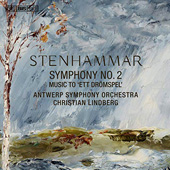
ESSENTIAL RECORDINGS

For a composer who, like Brahms, was initially riddled with self doubt and low confidence in his own skills because he was an autodidact musician with limited understanding of musical theory, Swedish composer Wilhelm Stenhammar (1871-1927) certainly demonstrated to himself, and musical society, that he could write music as well crafted and skilfully executed as any of his contemporaries, if somewhat less in keeping with the times. But unlike Brahms who fought to expel the weight of Beethoven from his shoulders, Stenhammar had to overcome the present day dominance of figures like Richard Strauss, Mahler, Nielsen and Sibelius, with whom he developed a frienship over time. Like Gustav Mahler, from whom I'm convinced he quotes at the 1:24 mark in the first movement, most of his composing was done during the summer months, as the rest of the year was devoted to conducting. It took him four years to complete his Symphony No. 2 in G minor, Op. 34, a work as lyrical and expressive as it is punctilious. The first and second movement's expressive touches more than offset the final's logic.
Stenhammar wasn't convinced that he should follow the crowd surging forward into the 20th century, so he immersed himself in the lifelong study of counterpoint which directed his scrutiny backward rather than forward. But instead of focusing his attention on the fugue, considered the touchstone as far as counterpoint is concerned, but dealing only with repetition and imitation, he forced himself through self-administered assignments, to write logical and autonomous counter-melodies to a predetermined foundation, just like Renaissance composers would do when writing four-part masses. Evidence of this self-taught mastery of advanced counterpoint reveals itself in his inclusion of a double fugue within the final movement of the symphony.
All this hard work didn't win him any friends at the time since most critics found all this complex juggling and manipulation of voices hard to follow. But now this symphony is considered by many to be an imposing symphonic statement for its time. Therefore, Stenhammar was actually, but unintentionally and against his own objectives, ahead of his time.
Being Swedish, BIS Records have always championed the music of Wilhelm Stenhammar. This particular symphony was recorded by BIS back in 1983, with the Gothenburg Symphony Orchestra under the direction of Neeme Järvi. This new Hybrid SACD recording with the Antwerp Symphony Orchestra (formerly the Royal Flemish Philharmonic) conducted by Christian Lindberg benefits from a slightly more relaxed tempo and a broader sense of scope. Christian Lindberg well projects the Scherzo's lighter mood, and the chatter of the woodwinds in the central episode, under his direction, well capture this work's Nordic character.
Jean-Yves Duperron - August 2018